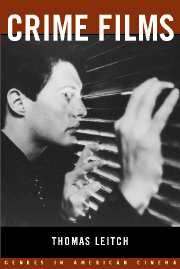Book contents
- Frontmatter
- Contents
- List of Illustrations
- Acknowledgments
- 1 The Problem of the Crime Film
- 2 Historical and Cultural Overview
- 3 Critical Overview
- 4 Fury and the Victim Film
- 5 The Godfather and the Gangster Film
- 6 Double Indemnity and the Film Noir
- 7 Basic Instinct and the Erotic Thriller
- 8 Murder on the Orient Express, Blue Velvet, and the Unofficial-Detective Film
- 9 Chinatown and the Private-Eye Film
- 10 Bullitt and the Police Film
- 11 Reversal of Fortune and the Lawyer Film
- 12 Fargo and the Crime Comedy
- 13 Conclusion: What Good Are Crime Films?
- Notes
- Selected Bibliography
- Filmography/Videography
- Index
7 - Basic Instinct and the Erotic Thriller
Published online by Cambridge University Press: 27 October 2009
- Frontmatter
- Contents
- List of Illustrations
- Acknowledgments
- 1 The Problem of the Crime Film
- 2 Historical and Cultural Overview
- 3 Critical Overview
- 4 Fury and the Victim Film
- 5 The Godfather and the Gangster Film
- 6 Double Indemnity and the Film Noir
- 7 Basic Instinct and the Erotic Thriller
- 8 Murder on the Orient Express, Blue Velvet, and the Unofficial-Detective Film
- 9 Chinatown and the Private-Eye Film
- 10 Bullitt and the Police Film
- 11 Reversal of Fortune and the Lawyer Film
- 12 Fargo and the Crime Comedy
- 13 Conclusion: What Good Are Crime Films?
- Notes
- Selected Bibliography
- Filmography/Videography
- Index
Summary
Twenty-five years after the film noir cycle ended with Kiss Me Deadly (1955) and Touch of Evil (1958), noir returned with a vengeance in 1981 with Body Heat and a remake of The Postman Always Rings Twice, which mark the resurgence of a new cycle of neo-noirs defined alike by their borrowings and their distance from the earlier cycle. Retro genres, by definition, must offer something new to distinguish themselves from their models, and the something in this new cycle is sex. The self-alienation that had been noir's keynote had not necessarily been driven by sex — as Christopher Nolan demonstrated in his neo-noir Memento (2000), whose backward scene-by-scene trajectory into the past cleverly dramatizes its avenging hero's loss of short-term memory — but sex is what the new cycle was selling.
The newly resurgent neo-noirs are driven by three developments in the sociology of American sexuality: the sexual freedom made possible by the widespread availability of contraception and abortion; the replacement of the Hays Office's 1930 Production Code by the Motion Picture Association of America's system of age-appropriate ratings, beginning in 1969; and the dramatic political and social changes provoked by the women's liberation movement in the 1970s. Just as issues concerning women's empowerment were coming to the fore for the first time since the years immediately following the war, the film industry was undergoing a revolution in its portrayal of sexual behavior.
- Type
- Chapter
- Information
- Crime Films , pp. 146 - 169Publisher: Cambridge University PressPrint publication year: 2002



